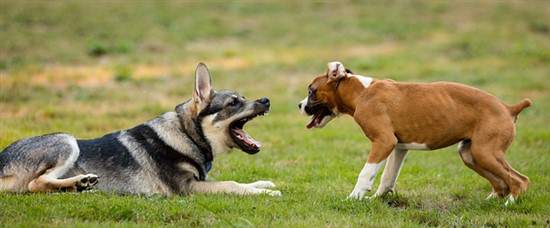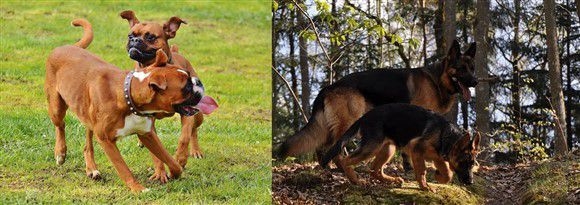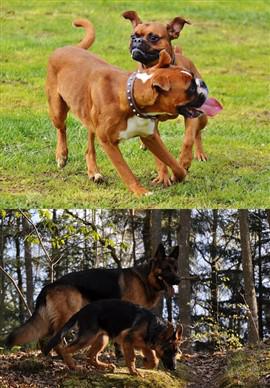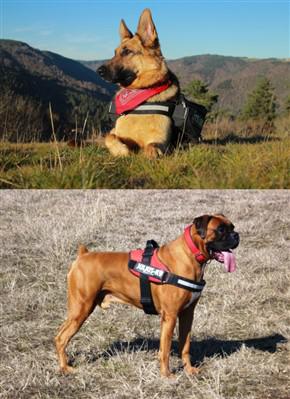The Boxer VS The German Shepherd
Overview
In an ongoing project, there will be articles comparing the Boxer dog to other breeds. Though there are over 300 others to choose from for comparison, you'll only see the ones that make sense.
For this particular side-by-side, we got together with our friends at
The Daily Shep
to bring you an interesting and fun article comparing the Boxer vs. German Shepherd dog breeds.
We will discuss a few topics and frequently asked questions - from breed history, to stat comparisons to which breed might be better around families, and as guard dogs.
Without further ado, let’s have a look at these surprisingly similar breeds, that don’t appear to have a lot in common, at least from their looks…
Please note: AllBoxerInfo is reader-supported. Some of the product suggestions on this page are affiliate links. As an Amazon Associate we earn from qualifying purchases. This is at no extra cost to you and helps keep this site running.
Boxer vs German Shepherd Origin and History
The Boxer and German Shepherd (GSD - short for German Shepherd Dog) have a remarkably close tie in both origins and history.
The first Boxer named Flocki, was born in Germany from the Bullenbeisser (breed now extinct) and the British Bulldog descent in the 1890’s.
The first German Shepherd, Horand von Grafath, was also first recognized and registered in Germany in the 1890’s.
Both breeds were bred to be working dogs, with the Boxer being bred originally for hunting and holding prey, and later guarding.
GSDs were bred as herding dogs, tending to flocks of sheep and livestock, but have since been used in an extremely diverse range of roles, from the military to search and rescue.
Boxer vs German Shepherd Popularity
In regard to
the most popular dogs, as it stands in the United States, German Shepherds are the second most popular dog breed among dog owners (they've maintained this ranking for the past 3 years), whilst Boxers aren’t far behind as the tenth most popular (they placed #7 in 2013, #8 in 2014 and was at #10 in 2015).
Boxer vs German Shepherd Size and Physical Traits
Boxers
are considered a medium to large breed of dog.
Males average 23-25 inches (58.42-63.5 cm) and 60-70 pounds (27-32 kg), whilst females generally come in slightly smaller at 55-65 pounds (25-29 kg) and are slightly shorter at 21.5-23.5 inches (54.6-59.7 cm).
They are characterized in color by their short brindle or fawn coat, black mask/face and sometimes white markings on the underbelly.
Some Boxers can be found in white, though this is not an accepted AKC color.
Notable physical features are their brachycephalic skulls which are condensed (similar to the Boston Terrier), powerful jaws with an under bite, and their thick muscular chests.
German Shepherds
are a large breed that average 60-65 cms (24-26 in), and 30-40 kg (66-88 lb) as males. Females average 55-60 cms (22-24 in), and 22-32 kg (49-71 lb).
They can have either short or long haired coats (generally shedding a lot more than a Boxer), and come in a range of colors from blue to black, with short haired/plush coat black and tan being the standard.
GSDs have longer faces than Boxers, and their ears often stand erect compared to the natural often floppy ears of the Boxer.
German Shepherds are also powerful, quick and agile – just like the Boxer, which is mandatory as a working dog.
Side by Side Stats Boxer VS German Shepherd
AKC recognition:
1904 | 1908
Family: Working
| Herding
Coloring: 2 colors, 3 markings
| 11 colors, no markings
Size: Females: 55-65 lbs. (25-29 kg), Males: 60-70 lbs. (27-32 kg)
Females: 49-71 lbs. (22-32 kg), Males: 66-88 lbs. 30-40 kg)
Life span: 9-12 years
| 9-13 years
Litter size: 3-12, 6 on average
| 1-15, 8 on average
Maturity rate: Adult at 2 years old
| Adult at 2 years old
Boxer photo: Borisz, 8 years old;
"Always on duty"
Photo courtesy of Karoly Tihanyi, Pécel Hungary

A German Shepherd and a young Boxer at play
Boxer vs German Shepherd Temperament, Exercise and Intelligence
Dogs are like humans in that they can each have their own individual personalities, but most breeds still maintain certain temperament traits from breed lines or original breeding purposes.
One major similarity in the temperament of Boxers and GSDs is their deep love and loyalty for family members, and wariness around strange people and other dogs (especially other big dogs they see as threats).
Both breeds have good guarding instincts, so identifying threats to them, their territory and their family comes naturally.
One difference is that Boxers do tend to be a bit more playful and gregarious in general, particularly around those they know.
German Shepherds tend to sit back more and observe, but are extremely energetic and playful when engaged to play, or when they want to be.
Regular daily exercise
and large amounts mental stimulation is important with both GSDs and Boxers to meet their physical and mental requirements.
Both breeds are intelligent – with the German Shepherd probably having more trainability than the Boxer on the whole, with the Intelligence of Dogs by Dr. Stanley Coren
identifying the GSD as the third brightest breed for understanding new commands.
Boxer vs German Shepherd Health Concerns
Cardiomyopathy is only common with certain breeds, the Boxer included, and one of the major symptoms is an irregular heartbeat, which requires specific testing.
As larger breeds of dogs around and over 60 pounds, both Boxers and German Shepherds are more commonly susceptible to the joint disease canine hip (and elbow) dysplasia, compared to their small breed counterparts.
Whether picking your dog up from a rescue, or even a trusted breeder, it is best practice to ensure your dog’s hips and elbows have been vet checked for this genetic disorder.
A vet recommended dog food diet with natural nutrients and compounds for joint health is one way to minimize joint problems, whilst some owners also choose to feed their dog joint supplements and purchase a dog bed with plenty of support from hard surfaces like an orthopedic dog bed for example.
Sticking to the recommended daily calorie intake, particularly as the dog ages, is important for both breeds – as obesity is a common problem among any larger dog.
Boxer vs German Shepherd - Guard Dog – Which is Better?
Both the Boxer and the German Shepherd make excellent guard dogs for families – with both breeds having a natural instinct to identify threats in their environment.
They each show confidence, awareness and obviously have the physical capabilities to intimidate and warn off intruders.
Caninejournal.com
rates German Shepherds as the number one breed as a guard dog for families, whilst Boxers come in at an also impressive sixth.
Boxer vs German Shepherd - For Families – Which Is Better?
Both breeds are extremely loving and affectionate towards family members including both adults and children/kids.
Make sure you socialize your dog with other dogs and particularly young children, so they learn the correct behaviors and have positive experiences from a young age.
The one thing to note about both breeds is they can show a higher dominance drive around other dogs, and might try to hunt cats, birds and smaller animals.
Always introduce your dog to other animals in the household before bringing them in permanently to avoid confrontations and territory disputes between your pets.



